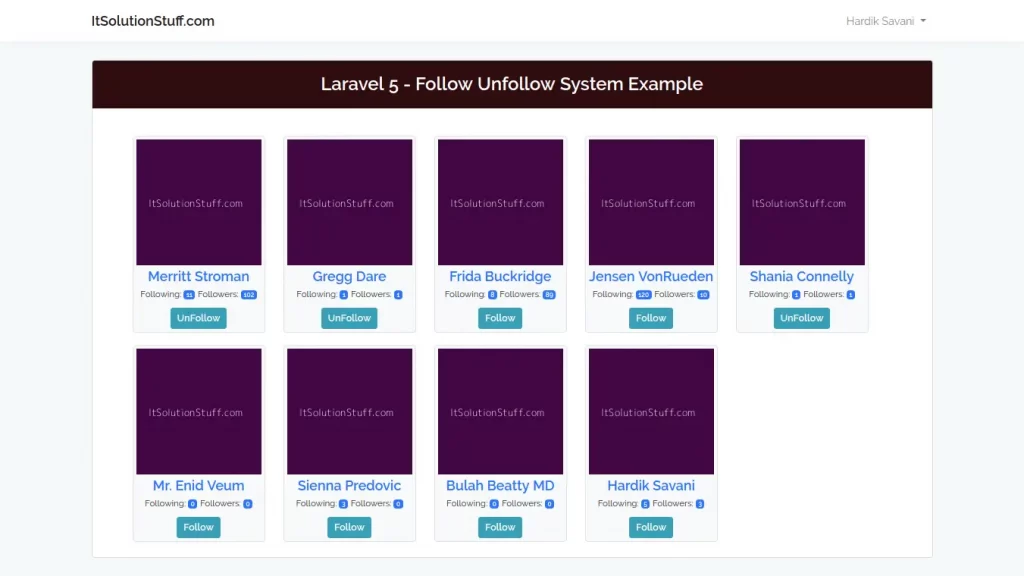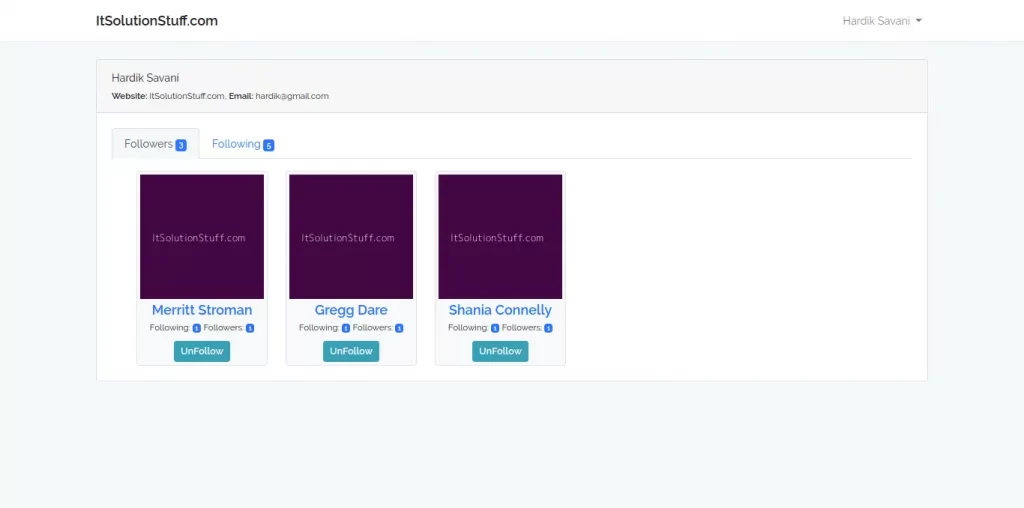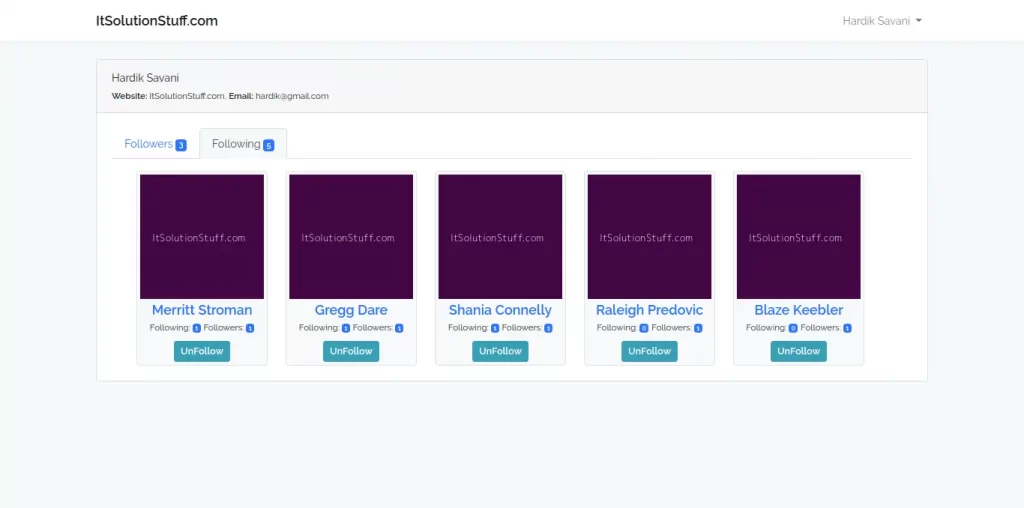Hi Guys,
Today I have a special tutorial for you developer, I would like to share with you how to implement a follow and unfollow system with PHP Laravel and MySQLi like Twitter and Facebook. So basically, a user can follow unfollow another user and you can see which users following you and how many followers you have.
So, in this post. I will explain you step by step create follow system in laravel 5, laravel 6, laravel 7, laravel 8 and laravel 9 application. we will use “overture/laravel-follow” composer package for following a system. we will create users table and user authentication using laravel auth. then a user can log in and see how many he has followers and following you.
Just follow a few step and you will get layout like as bellow preview and also you can download script from bellow link.
Preview Of All Users:

Preview Of User Follower:

Preview Of User Following:

Step 1: Install Laravel 5.6
In first step, If you haven’t installed laravel 5.6 in your system then you can run bellow command and get fresh Laravel project.
composer create-project --prefer-dist laravel/laravel blog
Step 2: Install laravel-follow Package
Now we require to install laravel-follow package for like unlike system, that way we can use it’s method. So Open your terminal and run bellow command.
composer require overtrue/laravel-follow
Now open config/app.php file and add service provider and aliase.
config/app.php
'providers' => [
....
Overtrue\LaravelFollow\FollowServiceProvider::class,
],
After that we need to run migration configure file that we it will automatic generate migrations. so let’s run.
php artisan vendor:publish --provider='Overtrue\LaravelFollow\FollowServiceProvider' --tag="migrations"
Then just migrate it by using following command:
php artisan migrate
Step 3: Create Authentication
In this step we require to create authentication of Laravel 5.6, so laravel provide artisan command to create authentication that way we don’t require to create route and controller for login and registration. so run bellow command:
php artisan make:auth
Step 4: Create Dummy Users
In this step, we will create some dummy users for testing, so we will create dummy users using formate factory. so run below command:
php artisan tinker
factory(App\User::class, 100)->create();
Step 5: Update User Model
here we need to update User model. we need to use CanLike facade in User model. So let’s update as bellow code.
App/User.php
<?php
namespace App;
use Illuminate\Notifications\Notifiable;
use Illuminate\Foundation\Auth\User as Authenticatable;
use Overtrue\LaravelFollow\Traits\CanFollow;
use Overtrue\LaravelFollow\Traits\CanBeFollowed;
class User extends Authenticatable
{
use Notifiable, CanFollow, CanBeFollowed;
/**
* The attributes that are mass assignable.
*
* @var array
*/
protected $fillable = [
'name', 'email', 'password',
];
/**
* The attributes that should be hidden for arrays.
*
* @var array
*/
protected $hidden = [
'password', 'remember_token',
];
}
Step 6: Add Routes
In this step, we will create routes for like unlike system. So we require to create following route in web.php file.
routes/web.php
Route::get('/', function () {
return view('welcome');
});
Auth::routes();
Route::get('/home', 'HomeController@index')->name('home');
Route::get('users', 'HomeController@users')->name('users');
Route::get('user/{id}', 'HomeController@user')->name('user.view');
Route::post('ajaxRequest', 'HomeController@ajaxRequest')->name('ajaxRequest');
Step 7: Create Controller Method
now in HomeController, we will add three new method users(), user() and ajaxRequest(). so let’s see HomeController like as bellow:
app/Http/HomeController.php
<?php
namespace App\Http\Controllers;
use Illuminate\Http\Request;
use App\User;
class HomeController extends Controller
{
/**
* Create a new controller instance.
*
* @return void
*/
public function __construct()
{
$this->middleware('auth');
}
/**
* Show the application of itsolutionstuff.com.
*
* @return \Illuminate\Http\Response
*/
public function index()
{
return view('home');
}
/**
* Show the application of itsolutionstuff.com.
*
* @return \Illuminate\Http\Response
*/
public function users()
{
$users = User::get();
return view('users', compact('users'));
}
/**
* Show the application of itsolutionstuff.com.
*
* @return \Illuminate\Http\Response
*/
public function user($id)
{
$user = User::find($id);
return view('usersView', compact('user'));
}
/**
* Show the application of itsolutionstuff.com.
*
* @return \Illuminate\Http\Response
*/
public function ajaxRequest(Request $request){
$user = User::find($request->user_id);
$response = auth()->user()->toggleFollow($user);
return response()->json(['success'=>$response]);
}
}
Step 8: Create Blade files and JS File
Now in this file we will need to create userList.blade.php, users.blade.php and usersView.blade.php files and custom.js file. So let’s create both files.
resources/views/users.blade.php
@extends('layouts.app')
@section('content')
<script src="{{ asset('js/custom.js') }}" defer></script>
<div class="container">
<div class="row justify-content-center">
<div class="col-md-12">
<div class="card">
<div class="card-header">List of Users- ItSolutionStuff.com</div>
<div class="card-body">
<div class="row pl-5">
@include('userList', ['users'=>$users])
</div>
</div>
</div>
</div>
</div>
</div>
@endsection
resources/views/usersView.blade.php
@extends('layouts.app')
@section('content')
<script src="{{ asset('js/custom.js') }}" defer></script>
<div class="container">
<div class="row justify-content-center">
<div class="col-md-12">
<div class="card">
<div class="card-header">
{{ $user->name }}
<br/>
<small>
<strong>Website:</strong> ItSolutionStuff.com,
<strong>Email: </strong>{{ $user->email }}
</small>
</div>
<div class="card-body">
<nav>
<div class="nav nav-tabs" id="nav-tab" role="tablist">
<a class="nav-item nav-link active" id="nav-home-tab" data-toggle="tab" href="#followers" role="tab" aria-controls="nav-home" aria-selected="true">Followers <span class="badge badge-primary">{{ $user->followers()->get()->count() }}</span></a>
<a class="nav-item nav-link" id="nav-profile-tab" data-toggle="tab" href="#following" role="tab" aria-controls="nav-profile" aria-selected="false">Following <span class="badge badge-primary">{{ $user->followings()->get()->count() }}</span></a>
</div>
</nav>
<div class="tab-content" id="nav-tabContent">
<div class="tab-pane fade show active" id="followers" role="tabpanel" aria-labelledby="nav-home-tab">
<div class="row pl-5">
@include('userList', ['users'=>$user->followers()->get()])
</div>
</div>
<div class="tab-pane fade" id="following" role="tabpanel" aria-labelledby="nav-profile-tab">
<div class="row pl-5">
@include('userList', ['users'=>$user->followings()->get()])
</div>
</div>
</div>
</div>
</div>
</div>
</div>
</div>
@endsection
resources/views/userList.blade.php
@if($users->count())
@foreach($users as $user)
<div class="col-2 profile-box border p-1 rounded text-center bg-light mr-4 mt-3">
<img src="https://dummyimage.com/165x166/420542/edeef5&text=ItSolutionStuff.com" class="w-100 mb-1">
<h5 class="m-0"><a href="{{ route('user.view', $user->id) }}"><strong>{{ $user->name }}</strong></a></h5>
<p class="mb-2">
<small>Following: <span class="badge badge-primary">{{ $user->followings()->get()->count() }}</span></small>
<small>Followers: <span class="badge badge-primary tl-follower">{{ $user->followers()->get()->count() }}</span></small>
</p>
<button class="btn btn-info btn-sm action-follow" data-id="{{ $user->id }}"><strong>
@if(auth()->user()->isFollowing($user))
UnFollow
@else
Follow
@endif
</strong></button>
</div>
@endforeach
@endif
publis/js/custom.js
$(document).ready(function() {
$.ajaxSetup({
headers: {
'X-CSRF-TOKEN': $('meta[name="csrf-token"]').attr('content')
}
});
$('.action-follow').click(function(){
var user_id = $(this).data('id');
var cObj = $(this);
var c = $(this).parent("div").find(".tl-follower").text();
$.ajax({
type:'POST',
url:'/ajaxRequest',
data:{user_id:user_id},
success:function(data){
console.log(data.success);
if(jQuery.isEmptyObject(data.success.attached)){
cObj.find("strong").text("Follow");
cObj.parent("div").find(".tl-follower").text(parseInt(c)-1);
}else{
cObj.find("strong").text("UnFollow");
cObj.parent("div").find(".tl-follower").text(parseInt(c)+1);
}
}
});
});
});
Now you are ready to run full example.
You can also download full source code of this example.
I hope it can help you….


